Abstract
The application of an environmentally friendly plant growth regulator to regulate plant growth and development represents a promising strategy for sustainable agriculture. Thymol is a kind of plant-derived natural compound. We have found that thymol is a potential biostimulant with the capability to trigger plant defense against abiotic stresses. Little is known about whether and how thymol modulates plant root system architecture. In this study, physiological, histochemical, and molecular approaches were applied to identify the role of thymol in promoting lateral root development in watermelon seedlings. Thymol significantly promoted LRP (lateral root primordia) initiation and lateral root formation. Rboh (respiratory burst oxidase homolog)-dependent reactive oxygen species (ROS) generation was involved in thymol-promoted lateral root development from LRP. Then, the Rboh gene family with nine members (ClRboh1–ClRboh9) was identified from watermelon genome. Thymol significantly induced the expression of a set of ClRbohs in roots. These results suggested that thymol was able to stimulate lateral root formation by triggering Rboh-dependent ROS production. These findings may help understand the biological function of thymol as an elicitor of lateral root in both applied and fundamental study.
1. Introduction
Lateral root, a new organ developed in root branching, is important for plants to acquire nutrients and water. The first step of LR organogenesis is LRP (lateral root primordium) initiation from the endodermis of primary root. Then, LRP germinates and breaks through exodermis to form lateral root []. LR organogenesis is governed by complicated regulatory networks involving various endogenous signaling molecules, such as auxin [], nitric oxide [], hydrogen sulfide [], carbon monoxide [], Ca2+ [], and ROS (reactive oxygen species) []. Auxin is considered to be a regulatory hub connecting other signals [,,], but ROS may also facilitate lateral root formation in a way independent of auxin []. Rboh (respiratory burst oxidase homolog) is a plasma membrane-located enzyme producing ROS. The Rboh gene family with multiple members has been identified extensively in different plant species []. Rboh-produced ROS has been found to be important for lateral root regulation by prior research (including ourselves) [,]. This provides a probable target for the regulation of lateral root formation.
Reasonable green fertilization is important to develop sustainable agriculture for the promotion of crop growth in order to meet the demand of the expanding population worldwide [,]. Using plant growth regulators is an effective management to modulate plant development and enhance yield []. Plant-based natural compounds are considered as promising plant growth regulators for the development of sustainable agriculture []. Thymol, the main component of essential oils in species of Thymus, has antimicrobial, anti-inflammatory, and immunostimulatory activities []. Thymol regulates mammalian cells’ physiology by modulating a set of signaling molecules. Endogenous nitric oxide is involved in thymol ameliorating indomethacin-induced gastric ulcer in rats []. Thymol is able to regulate Ca2+ in mammalian ventricular cardiomyocyte cells []. We have demonstrated that thymol can prime plant defense responses against abiotic stress [], revealing its potentiality in regulating plant physiology. Thymol regulates similar signaling in plants as compared to in mammals. For instance, thymol regulates plant tolerance against cadmium and saline stress by differentially modulating endogenous nitric oxide [,]. ROS homeostasis has been associated with thymol-regulated tolerance against excessive ammonium []. All of these signaling molecules modulated by thymol are also involved in the regulation of lateral root formation. This drives us to think about the possibility of thymol-regulated lateral root development.
In this work, we identified the function of thymol in the promotion of lateral root of watermelon seedlings. Then, we discovered the role of Rboh-ROS in this process. These findings would help to understand the biological function of thymol in both applied and fundamental agricultural research.
2. Materials and Methods
2.1. Plant Growth and Treatment
This hydroponic study was conducted in order to analyze root phenotype without damaging the roots. The watermelon seeds were surface-sterilized with 1% NaClO for 15 min, followed by washing with distilled water three times. Then, the seeds were soaked in distilled water for 4 h, followed by germinating in darkness. Identical seedlings with a radicle length of 0.5 cm were selected and transferred to a container with Hoagland solution containing KNO3 (126.44 mg/L), Ca(NO3)2 (164.1 mg/L), KH2PO4 (33.95 mg/L), NH4NO3 (19.93 mg/L), MgSO4 (60.19 mg/L), FeSO4·7H2O (1.33 mg/L), H3BO3 (0.71 mg/L), CuSO4 (0.02 mg/L), MnSO4·H2O (0.604 mg/L), ZnSO4 (0.055 mg/L), and MoO3 (0.004 mg/L). The growth conditions for the seedlings were as follows: temperature of 26 °C, photosynthetic active radiation of 200 μmol/m2/s, photoperiod of 16 h/8 h (day/night), and relative humidity of 75%. Ten seedlings were cultured in a container with 700 mL nutrient solution. Other chemicals including thymol were added to the nutrient solution according to different experimental treatments. Seedling roots were exposed to thymol (25–200 μM) for up to 5 days. Imidazole (IMZ) at 0.3 mM was applied as Rboh inhibitor []. After treatment, the roots were harvested for physiological measurements.
2.2. Quantification of Lateral Root and LRP
Each seedling root was put into water in order to let the lateral roots spread out for the quantification of lateral root. LRP was stained and visualized with methylene blue []. Basically, primary roots were fixed with acetic acid/ethanol (1/3, v/v) for 24 h at 4 °C. Then, the roots were washed with sodium hypochlorite (50%, v/v) for 10 min. After that, the roots were incubated in methylene blue (0.01%, w/v) for 5 min to visualize and quantify LRP under microscope. The lateral root density and LRP density were calculated as lateral root number/primary root length and LRP number/primary root length, respectively.
2.3. Fluorescent Detection of ROS in LRP
Endogenous ROS in roots were detected in vivo with a specific fluorescent probe DCFH-DA (2′,7′-dichlorofluorescein diacetate) []. The roots were incubated in DCFH-DA (10 μM) for 15 min followed by washing with distilled water three times in order to remove attached probes on the root surface. Then, the DCF (dichlorofluorescein) fluorescence indicating ROS in roots was observed and captured under a fluorescent microscope (Eclipse, TE2000-S, Nikon, Melville, NY, USA).
2.4. Determination of ROS Content in Roots
Total ROS content in roots was measured using a commercial test kit (E004-1-1, Nanjing Jiancheng Bioengineering Institute, Nanjing, China) based on the detection of DCF fluorescent density according to the instructions of the manufacturer. Basically, 0.1 g fresh root tissue was homogenized with the extraction buffer provided by the kit. The homogenate was centrifuged at 10,000 rpm at 4 °C. Then, the supernatant was collected and mixed with DCFH-DA solution in the kit for 10 min. The fluorescence was recorded with a microplate reader (Varioskan ALF, ThermoFisher SCIENTIFIC, Waltham, MA, USA) for the quantification of ROS.
2.5. Analysis of ClRboh Gene Family in Watermelon
The sequence of ClRboh family members was retrieved from the genome of watermelon (Citrullus lanatus) (https://plants.ensembl.org/Citrullus_lanatus/Info/Index, accessed on 1 October 2024) based on functional domain search. The phylogenetic tree was constructed based on the amino acid sequences of Rboh members from watermelon (ClRbohs), tomato (SlRbohs), rice (OsRbohs), and Arabidopsis thaliana (AtRbohs) by using MEGA-X. The conserved domains in all ClRbohs were characterized using InterPro []. The basic properties of ClRbohs were analyzed using ProtParam []. Transmembrane domains were characterized by using TMHMM-2.0 []. The gene structure of ClRbohs was analyzed using GSDS []. The chromosomal localization of ClRbohs was analyzed using MG2C [].
2.6. Quantification of Gene Transcripts
Total RNA was extracted from roots by using RNAprep Pure Plant RNA Extraction Kit (DP432, Tiangen Biotech Co., Ltd., Beijing, China). Then, the cDNA was synthesized using GoldenstarTM RT6 cDNA Synthesis Kit (Beijing Tsingke Biotech Co., Ltd., Beijing, China). The obtained cDNA was used as a template to perform qPCR (quantitative polymerase chain reaction) with SYBR Green I Master qPCR Mix (Beijing Tsingke Biotech Co., Ltd., Beijing, China) by using LightCycler® 480 II (Roche Diagnostics (Shanghai) Ltd., Shanghai, China). The qPCR procedure was set as follows: initial denaturation at 95 °C for 60 s, followed by 40 cycles of 95 °C for 10 s and 60 °C for 30 s. The relative abundance of β-actin was measured as internal standard to normalize the expression level of designated genes. The sequences of primers are listed in Table 1.

Table 1.
Primer sequences used for qPCR analysis.
2.7. Statistical Analysis
The data are presented as the mean of three to six replicates with standard deviation (SD). The significant difference between two data sets was evaluated based on ANOVA (one-way analysis of variance) with F-test at p < 0.05 or p < 0.01. For multiple comparison among more than three data sets, LSD (least significant difference) was performed to analyze significant difference at p < 0.05.
3. Results
3.1. Thymol Promotes Lateral Root Formation and LRP Emergence
Compared to the control, the lateral root number significantly increased by 19.7%, 29.1%, and 37.6% under thymol at 25, 50, and 100 μM, respectively. However, the lateral root number decreased with the continuous increase in the thymol concentration (200 μM) (Figure 1A,B). The primary root number decreased with the increase in the thymol concentration (Figure 1C). The lateral root density significantly increased by 25.7%, 49.2%, 70.5%, and 47.6% under thymol at 25, 50, 100, and 200 μM, respectively (Figure 1D). These results indicated that thymol promoted lateral root formation in a dose-dependent manner, with the maximum effect occurring at 100 μM.
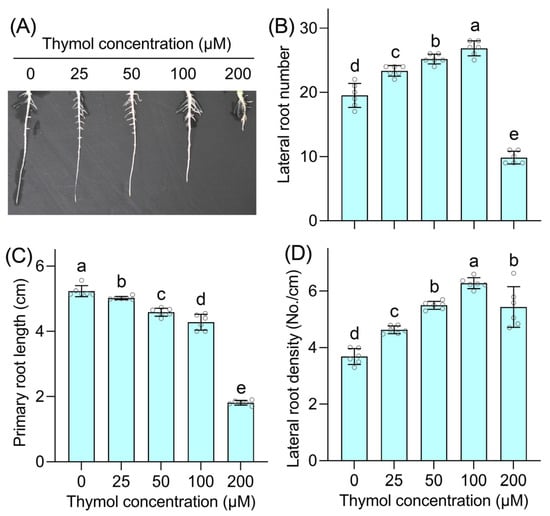
Figure 1.
Dose-dependent effect of thymol on lateral root number of watermelon seedling. (A) Phenotype of lateral root. (B) Lateral root number. (C) Primary root length. (D) Lateral root density. Different lowercase letters in (B–D) indicate significant difference among different treatments (LSD, n = 6, p < 0.05).
Then, we monitored the lateral root formation upon thymol at 100 μM in a time-course experiment. The lateral root number began to increase after thymol treatment for 2 days. The lateral root number increased with prolonged monitoring until 5 days, but thymol resulted in a higher speed of lateral root emergence than that of the control (Figure 2A). The lateral root density showed similar changes to the lateral root number, which was significantly higher in the thymol treatment as compared to the control during 2–5 days (Figure 2B).
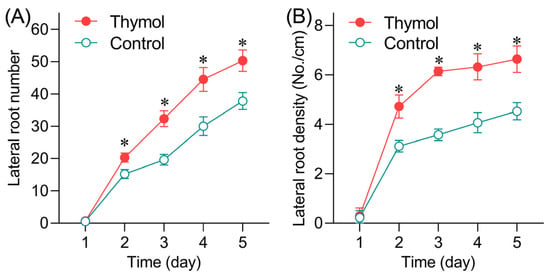
Figure 2.
Time-dependent effect of thymol on lateral root number of watermelon seedling. (A) Lateral root number. (B) Lateral root density. Asterisk indicates significant difference between treatment and control at each time point (ANOVA, n = 10, p < 0.05).
Treatment with thymol for 1 day remarkably increased the LRP number and LRP density in a dose-dependent manner with the maximum effect also occurring at 100 μM. The LRP number and LRP density increased by 31.2% and 45.8%, respectively, upon the exposure of thymol at 100 μM (Figure 3). These results suggested that thymol promoted lateral root formation by stimulating PLR initiation.
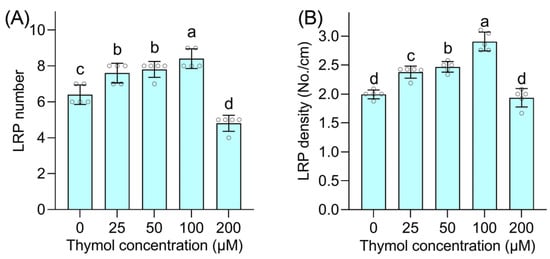
Figure 3.
Dose-dependent effect of thymol on LRP of watermelon seedling. (A) LRP number. (B) LRP density. Different lowercase letters indicate significant difference among different treatments (LSD, n = 5, p < 0.05).
3.2. ROS Is Involved in Thymol-Promoted Lateral Root and LRP Formation
To investigate the role of ROS in lateral root development, endogenous ROS in roots were labeled with DCFH to emit green fluorescence. ROS accumulation was clearly detected in the site of LRP initiation and emergence, suggesting that ROS may be involved in this process (Figure 4A). Thymol-stimulated lateral root formation accompanied the enhancement in the endogenous ROS level in roots (Figure 4B,C). Adding IMZ (an Rboh inhibitor) decreased the ROS level and lateral root number in thymol-treated root (Figure 4B–D). IMZ also antagonized the effect of thymol on the increase in the lateral root density, LRP number, and LRP density (Figure 4E–G). These results suggested that Rboh-dependent ROS production played a role in thymol-promoted lateral root formation.

Figure 4.
Involvement of ROS thymol-promoted lateral root formation. (A) ROS detection during LRP emergence. White arrows indicate LRP emergence. (B) Effect of IMZ on thymol-promoted lateral root number. (C) Effect of IMZ on thymol-promoted lateral root number. (D) Phenotype of lateral root number. (E) Effect of IMZ on thymol-promoted lateral root density. (F) Effect of IMZ on thymol-promoted LRP number. (G) Effect of IMZ on thymol-promoted LRP density. Different lowercase letters in (B,D–G) indicate significant difference among different treatments (LSD, n = 5, p < 0.05).
3.3. Identification of ClRboh Gene Family in Watermelon
A total of nine Rboh family members (ClRboh1-9) were identified from the watermelon genome. These ClRbohs have coding sequences of 2190–2850 bp, encoding for proteins with 729–949 amino acids. These proteins have a molecular weight of 84.07–108.35 kD and theoretical PI of 8.59–9.27 (Table 2). The ClRbohs distribute widely in different chromosomes (chr) (Table 2). ClRboh3 and ClRboh6 are closely located in chr2. ClRboh1 and ClRboh4 are located in the two ends of chr3. ClRboh2, ClRboh7, ClRboh8, and ClRboh9 are located in chr10, chr6, chr1, and chr9, respectively (Figure 5).

Table 2.
Basic characteristics of ClRboh family members.

Figure 5.
Chromosomal localization of ClRbohs.
Phylogenetic analysis of ClRbohs with AtRbohs, OsRbohs, and SlRbohs yielded a phylogenetic tree containing five subfamilies (Sub. 1–5) (Figure 6). ClRboh2 and ClRboh1 were in Sub. 1 and Sub. 2, respectively. ClRboh7 and ClRboh5 were in Sub. 3. ClRboh9 and ClRboh8 were in Sub. 4. ClRboh3, ClRboh4, and ClRboh6 were in Sub. 5. All the ClRbohs have typical Rboh conserved domains, such as NADPH_Ox, EF-hand, Ferric_reduct, FAD_binding_8, and NAD_binding_6 (Figure 7A). As membrane-localized proteins, ClRbohs have 4–6 transmembrane domains (Table 2). Most of the transmembrane domains were localized in and around the Ferric_reduct domain. In addition, six ClRbohs (ClRboh1, 2, 6, 7, 8, 9) have one transmembrane domain localized in the NAD_binding domain close to the C-terminus (Figure 7B). Gene structure analysis suggested that all the ClRbohs had multiple introns (8–13). Subfamily II (ClRboh2) has the fewest introns (8) while members in subfamily IV–V (ClRboh3, 4, 6, 8, 9) have more introns (12–13). Three ClRbohs (ClRboh7–9) had big introns with a length of more than 2.7 kb (Figure 7C).
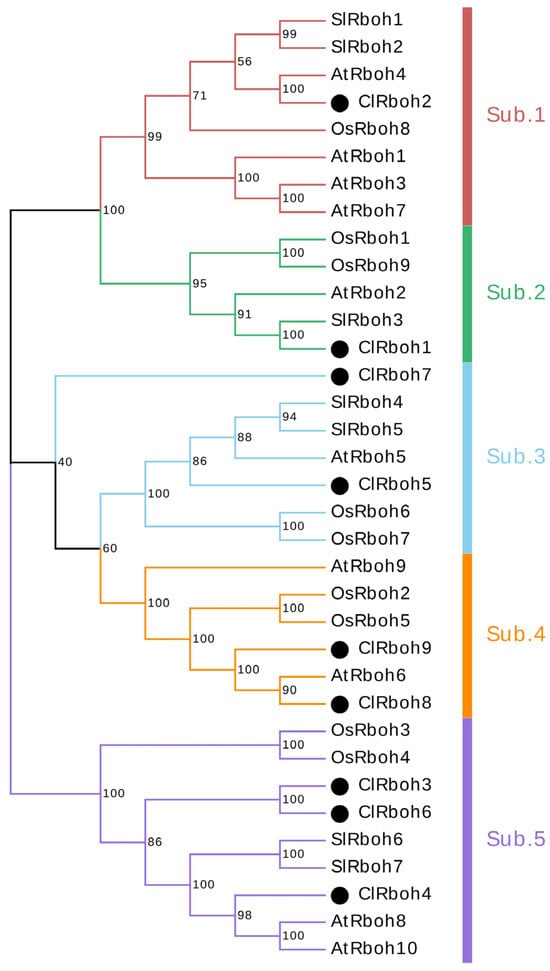
Figure 6.
Phylogenetic tree of ClRboh family members. The tree was constructed based on ClRbohs, rice Rbohs (OsRbohs), tomato Rbohs (SlRbohs), and Arabidopsis thaliana Rbohs (AtRbohs). Subfamily members are bracketed and numbered on the right of the tree.
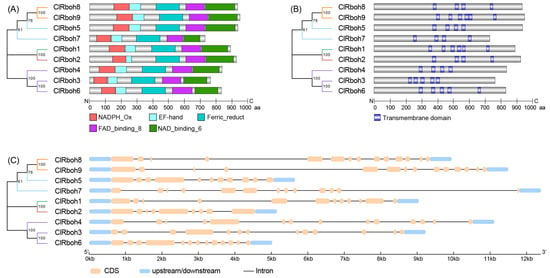
Figure 7.
Phylogenetic relationship among conserved domains (A), transmembrane domains (B), and gene structure of ClRbohs (C).
3.4. Thymol Upregulated the Expression of ClRbohs in Roots
As Rboh-ROS was involved in thymol-induced lateral root formation, we further detected the expression of ClRbohs in roots in response to thymol. Among all nine ClRbohs, five ClRbohs were significantly upregulated by thymol exposure (Figure 8). Compared to the control, the relative expression levels of ClRboh1, ClRboh3, ClRboh5, ClRboh6, and ClRboh7 were enhanced by 66.8%, 51.1%, 61.5%, 54.0%, and 84.3%, respectively. The expression of other ClRbohs was not impacted significantly by thymol treatment.
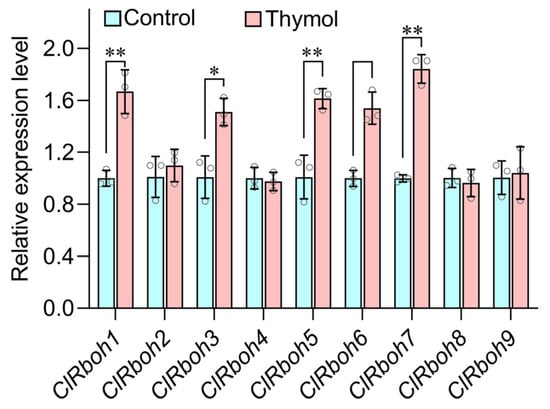
Figure 8.
Effect of thymol on the expression of ClRbohs in roots. Asterisk (*) and double asterisk (**) indicate significant difference between thymol and control at p < 0.05 and p < 0.01, respectively (ANOVA, n = 13).
4. Discussion
Mining the role of natural agrochemicals in regulating plant physiology is important for developing the technology of using plant growth regulators in sustainable agriculture []. Here, we found that thymol was able to stimulate root branching by promoting lateral root formation in watermelon seedlings. Some commercial products have shown the ability to elicit root branching, such as Maxstim’s complex biostimulant (Maxstim, Godalming, UK) and Hello Nature Quik-Link (HELLO NATURE®, Verona, Italia). For example, the Quik-Link product contains lateral root-promoting peptides. It can enhance the root surface area of melon transplants by approximately 22–47% in a field experiment. The Quik-Link product shows a dose-dependent effect on root branching with the highest effect occurring in a certain range of concentration []. This is very similar to the function of thymol in eliciting root branching. However, more tests are needed to evaluate the potential of applying thymol as a root elicitor in a field trial.
ROS is one of the ubiquitous signals that mediates lateral root formation under various exogenous stimulators [,,,]. In this study, ROS also played a role in thymol-induced lateral root development. ROS acts as a multifunctional signal to regulate various plant physiological processes including root development []. In situ labeling of ROS indicated that ROS accumulated in the sites where lateral root primes and germinates. LRP initiates from primary pericycle or endodermis, which is regulated by auxin signaling [,]. The regulatory mechanism for ROS in this process is still elusive, but ROS-facilitated cysteine thiol-based oxidative posttranslational modification of transcription factors may work on the modulation of auxin-regulated LRP development []. After LRP initiation, LRP begins to germinate and break through the exodermis to form lateral root. In this process, ROS may contribute to the cell wall loosening of exodermis cells in order to facilitate the lateral root emergence from the primary root []. Linking thymol-induced ROS production and ROS-facilitated lateral root development elucidates the role of ROS in mediating thymol-promoted lateral root formation.
Pharmaceutical experiments suggested that Robh was involved in thymol-induced ROS production. Here, we identified a watermelon Rboh gene family with nine members before confirming the promoting effect of thymol on their expressions. All the ClRboh proteins have an NADPH_Ox domain and an EF-hand (Ca2+-binding) motif close to the N-terminus and FAD_binding and NAD-binding close to the C-terminus, which is a conserved feature in plant Rbohs []. For the gene structure, the intron number has subfamily dependent characteristics. This is consistent with the intron distribution pattern of Rbohs in different plant species. For example, in subfamily IV, ClRboh8 and OsRboh9 have 13 introns. Their homologs in this subfamily like AtRboh6, AtRboh9, OsRboh2, and OsRboh5 also have 13 or more introns []. ClRboh members in subfamily I and II (ClRboh1 and ClRboh2) have relatively lower numbers of introns. ClRboh2 only has eight introns. Its homologs existing in Arabidopsis, rice, and tomato have 7–10 introns, which are fewer than other subfamily members [,]. Evolution of fewer introns may result in efficient gene transcription [], indicating a possibly quick response of ClRboh1 and OsRboh2 in plant development and adaptation.
Thymol was able to stimulate the expression of several ClRbohs (ClRboh1, 3, 5, 6, 7) that may be involved in the regulation of the whole process of lateral root development based on the role of their homologs in other plant species. AtRboh5 (also called AtRbohE) is a homolog ClRboh5 and ClRboh7. AtRboh5 is not only expressed inside the LRP but also in the cells of the endodermis, cortex, and epidermis, which is linked to both LRP initiation and epidermis cell wall remodeling for LR emergence []. SlRboh3 and SlRboh4 are the homologs of ClRboh1 and ClRboh5, respectively. The expression of SlRboh3 and SlRboh4 has been closely linked to LRP formation in tomato plant [], suggesting the possible role of ClRboh1 and ClRboh5 in LR development. ROS generated from multiple pathways plays different roles in regulating lateral root development. ROS from cell wall peroxidase is required for early lateral root emergency, but not for the early specification of LRP []. However, Rboh may have different functions. In Arabidopsis, AtRboh5 is supposed to be required for both LRP initiation and lateral root development []. Further studies focusing on the genetic modification of ClRboh homologs would help provide solid evidence for the involvement of specific ClRbohs in lateral root development.
Thymol may regulate Rboh in different ways. In Aspergillus flavus, thymol triggers Rboh-dependent ROS generation by inducing endogenous nitric oxide []. Thymol-regulated nitric oxide has been found in both plants and mammals [,]. Nitric oxide and ROS can work together to regulate root system architecture including lateral root formation []. Therefore, nitric oxide may be a mediator working upstream of Rboh-ROS in thymol-induced lateral root, which needs to be studied further. Thymol may also regulate Rboh at the posttranslational level. Ca2+ is an important messenger involved in lateral root development []. In mammalian cells, thymol can regulate Ca2+ signals by directly activating Ca2+ channel TRPA1 (transient receptor potential channel A1) []. Ca2+ is an important regulator of Rboh. Ca2+ can bind to the EF-hand domain of Rboh to enhance Rboh activity []. Therefore, thymol may regulate Rboh through the modulation of Ca2+ in lateral root formation. In mammals, the Rboh homolog is also called NOX. The interaction between thymol and human NOX (hNOX) may occur, showing the involvement of the phenyl ring of thymol into the pocket near Cys378 of hNOX []. Further studying the similar mechanisms for the interaction between thymol and Rboh may help explain how thymol regulates Rboh to promote lateral root formation.
Maintaining ROS homeostasis during lateral root development may involve both an ROS-generating and ROS-scavenging system because a high level of ROS may induce oxidative damage in plants. In Medicago truncatula, plant hormone ABA (abscisic acid) regulates root branching by differentially regulating MtRbohC and apoplastic Cu/ZnSOD (an enzyme for scavenging ROS) []. In addition, ROS can be scavenged by other antioxidants, such as ascorbic acid, glutathione, phenols, flavonoids, tocopherol, etc. [,]. Thymol triggers ROS generation in the roots of watermelon seedlings. Further studies are needed to investigate how thymol balances an ROS-generating and ROS-scavenging system to maintain a proper level of ROS that signals roots to initiate lateral root development without causing oxidative damage.
5. Conclusions
In this study, thymol is capable of promoting lateral root formation in watermelon seedlings by stimulating LRP initiation, a process mediated by Rboh-dependent ROS generation. Based on the genome identification of the Rboh gene family in watermelon and expression analysis, thymol selectively regulated the expression of several ClRbohs in the roots. These ClRbohs may contribute to thymol-induced ROS generation. The detailed mechanism is largely unknown, but our data provide important evidence to extend the biological function of thymol. Further studies focusing on how thymol differentially regulates Rbohs and cell differentiation during LRP initiation would help identify the molecular target of thymol in the regulation of plant system root architecture.
Author Contributions
Conceptualization, X.Y. and J.C.; methodology, J.L. and Y.H.; investigation, J.L., J.C., Y.L., Y.W., L.W. and C.L.; resources, X.Y.; writing—original draft preparation, J.L. and J.C.; writing—review and editing, L.H. and X.Y.; supervision, X.Y.; funding acquisition, J.C. and C.L. All authors have read and agreed to the published version of the manuscript.
Funding
This research was funded by “Jiangsu Province Social Development Project, grant number BE2022788”, “National Natural Science Foundation of China, grant number 32272208”, and “Jiangsu Agricultural Science and Technology Innovation Fund, grant number CX(22)3200”.
Data Availability Statement
The original contributions presented in this study are included in the article. Further inquiries can be directed to the corresponding author(s).
Acknowledgments
We thank Changwei Sun from Nanjing Agricultural University for his assistance in fluorescence microscopy.
Conflicts of Interest
The authors declare no conflicts of interest.
References
- Santos Teixeira, J.A.; Tusscher, K.H.T. The systems biology of lateral root formation: Connecting the dots. Mol. Plant 2019, 12, 784–803. [Google Scholar] [CrossRef] [PubMed]
- Cavallari, N.; Artner, C.; Benkova, E. Auxin-regulated lateral root organogenesis. Cold Spring Harb. Perspect. Biol. 2021, 13, a039941. [Google Scholar] [CrossRef] [PubMed]
- Correa-Aragunde, N.; Graziano, M.; Chevalier, C.; Lamattina, L. Nitric oxide modulates the expression of cell cycle regulatory genes during lateral root formation in tomato. J. Exp. Bot. 2006, 57, 581–588. [Google Scholar] [CrossRef]
- Li, H.; Chen, H.; Chen, L.; Wang, C. The role of hydrogen sulfide in plant roots during development and in response to abiotic stress. Int. J. Mol. Sci. 2022, 23, 1024. [Google Scholar] [CrossRef] [PubMed]
- Cao, Z.-Y.; Xuan, W.; Liu, Z.-Y.; Li, X.-N.; Zhao, N.; Xu, P.; Wang, Z.; Guan, R.-Z.; Shen, W.-B. Carbon monoxide promotes lateral root formation in rapeseed. J. Integr. Plant Biol. 2007, 49, 1070–1079. [Google Scholar] [CrossRef]
- Chen, Y.; Kao, C. Calcium is involved in nitric oxide- and auxin-induced lateral root formation in rice. Protoplasma 2012, 249, 187–195. [Google Scholar] [CrossRef]
- Chen, Z.; Gu, Q.; Yu, X.; Huang, L.; Xu, S.; Wang, R.; Shen, W.; Shen, W. Hydrogen peroxide acts downstream of melatonin to induce lateral root formation. Ann. Bot. 2018, 121, 1127–1136. [Google Scholar]
- Fang, T.; Cao, Z.; Li, J.; Shen, W.; Huang, L. Auxin-induced hydrogen sulfide generation is involved in lateral root formation in tomato. Plant Physiol. Biochem. 2014, 76, 44–51. [Google Scholar]
- Guo, K.; Xia, K.; Yang, Z.M. Regulation of tomato lateral root development by carbon monoxide and involvement in auxin and nitric oxide. J. Exp. Bot. 2008, 59, 3443–3452. [Google Scholar]
- Zhang, S.; Yu, R.; Yu, D.; Chang, P.; Guo, S.; Yang, X.; Liu, X.; Xu, C.; Hu, Y. The calcium signaling module CaM-IQM destabilizes IAA-ARF interaction to regulate callus and lateral root formation. Proc. Natl. Acad. Sci. USA 2022, 119, e2202669119. [Google Scholar] [CrossRef]
- Manzano, C.; Pallero-Baena, M.; Casimiro, I.; De Rybel, B.; Orman-Ligeza, B.; Van Isterdael, G.; Beeckman, T.; Draye, X.; Casero, P.; del Pozo, J.C. The emerging role of reactive oxygen species signaling during lateral root development. Plant Physiol. 2014, 165, 1105–1119. [Google Scholar] [CrossRef] [PubMed]
- Zhang, H.; Wang, X.; Yan, A.; Deng, J.; Xie, Y.; Liu, S.; Liu, D.; He, L.; Weng, J.; Xu, J. Evolutionary analysis of respiratory burst oxidase homolog (RBOH) genes in plants and characterization of ZmRBOHs. Int. J. Mol. Sci. 2023, 24, 3858. [Google Scholar] [CrossRef] [PubMed]
- Orman-Ligeza, B.; Parizot, B.; de Rycke, R.; Fernandez, A.; Himschoot, E.; Van Breusegem, F.; Bennett, M.J.; Périlleux, C.; Beeckman, T.; Draye, X. RBOH-mediated ROS production facilitates lateral root emergence in Arabidopsis. Development 2016, 143, 3328–3339. [Google Scholar] [CrossRef] [PubMed]
- Bian, L.; Wang, Y.; Bai, H.; Li, H.; Zhang, C.; Chen, J.; Xu, W. Melatonin-ROS signal module regulates plant lateral root development. Plant Signal. Behav. 2021, 16, 1901447. [Google Scholar] [CrossRef]
- Terzic, D.; Popovic, V.; Malić, N.; Ikanović, J.; Rajičić, P.S.; Lončar, M.; Lončarević, V. Effects of long-term fertilization on yield of siderates and organic matter content of soil in the process of recultivation. J. Anim. Plant Sci. 2019, 29, 790–795. [Google Scholar]
- Lakić, Ž.; Popović, V.; Ćosić, M.; Antić, M. Genotypes variation of Medicago sativa (L.) seed yield components in acid soil under conditions of cross-fertilization. Genetika 2022, 54, 1–14. [Google Scholar] [CrossRef]
- Tripathi, D.K.; Yadav, S.R.; Mochida, K.; Tran, L.-S.P. Plant growth regulators: True managers of plant life. Plant Cell Physiol. 2022, 63, 1757–1760. [Google Scholar]
- Zulfiqar, F.; Casadesús, A.; Brockman, H.; Munné-Bosch, S. An overview of plant-based natural biostimulants for sustainable horticulture with a particular focus on moringa leaf extracts. Plant Sci. 2020, 295, 110194. [Google Scholar] [CrossRef]
- Escobar, A.; Pérez, M.; Romanelli, G.; Blustein, G. Thymol bioactivity: A review focusing on practical applications. Arabian J. Chem. 2020, 13, 9243–9269. [Google Scholar] [CrossRef]
- Koc, K.; Cerig, S.; Ucar, S.; Colak, S.; Bakir, M.; Erol, H.S.; Yildirim, S.; Hosseinigouzdagani, M.; Simsek Ozek, N.; Aysin, F.; et al. Gastroprotective effects of oleuropein and thymol on indomethacin-induced gastric ulcer in Sprague-Dawley rats. Drug Chem. Toxicol. 2020, 43, 441–453. [Google Scholar] [CrossRef]
- Magyar, J.; Szentandrássy, N.; Bányász, T.; Fülöp, L.; Varró, A.; Nánási, P.P. Effects of thymol on calcium and potassium currents in canine and human ventricular cardiomyocytes. Br. J. Pharmacol. 2002, 136, 330–338. [Google Scholar] [CrossRef] [PubMed]
- Wang, T.T.; Shi, Z.Q.; Hu, L.B.; Xu, X.F.; Han, F.X.; Zhou, L.G.; Chen, J. Thymol ameliorates cadmium-induced phytotoxicity in the root of rice (Oryza sativa) seedling by decreasing endogenous nitric oxide generation. J. Agric. Food Chem. 2017, 65, 7396–7405. [Google Scholar] [PubMed]
- Xu, L.; Song, J.Q.; Wang, Y.L.; Liu, X.H.; Li, X.L.; Zhang, B.; Li, A.J.; Ye, X.F.; Wang, J.; Wang, P. Thymol improves salinity tolerance of tobacco by increasing the sodium ion efflux and enhancing the content of nitric oxide and glutathione. BMC Plant Biol. 2022, 22, 31. [Google Scholar]
- Guo, K.; An, G.; Wang, N.; Pang, B.; Shi, Z.; Bai, H.; Zhang, L.; Chen, J.; Xu, W. Thymol ameliorates ammonium toxicity via repressing polyamine oxidase-derived hydrogen peroxide and modulating ammonium transporters in rice root. Food Prod. Process. Nutri. 2021, 3, 7. [Google Scholar] [CrossRef]
- Hu, X.; Wang, W.; Li, C.; Zhang, J.; Lin, F.; Zhang, A.; Jiang, M. Cross-talks between Ca2+/CaM and H2O2 in abscisic acid-induced antioxidant defense in leaves of maize plants exposed to water stress. Plant Growth Regul. 2008, 55, 183–198. [Google Scholar]
- Wang, H.; Taketa, S.; Miyao, A.; Hirochika, H.; Ichii, M. Isolation of a novel lateral-rootless mutant in rice (Oryza sativa L.) with reduced sensitivity to auxin. Plant Sci. 2006, 170, 70–77. [Google Scholar]
- Blum, M.; Andreeva, A.; Florentino, L.C.; Chuguransky, S.R.; Grego, T.; Hobbs, E.; Pinto, B.L.; Orr, A.; Paysan-Lafosse, T.; Ponamareva, I.; et al. InterPro: The protein sequence classification resource in 2025. Nucleic Acids Res. 2024, 53, D444–D456. [Google Scholar] [CrossRef]
- Wilkins, M.R.; Gasteiger, E.; Bairoch, A.; Sanchez, J.C.; Williams, K.L.; Appel, R.D.; Hochstrasser, D.F. Protein identification and analysis tools in the ExPASy server. Methods Mol. Biol. 1999, 112, 531–552. [Google Scholar]
- Krogh, A.; Larsson, B.; von Heijne, G.; Sonnhammer, E. Predicting transmembrane protein topology with a hidden markov model: Application to complete genomes. J. Mol. Biol. 2001, 305, 567–580. [Google Scholar]
- Hu, B.; Jin, J.P.; Guo, A.Y.; Zhang, H.; Luo, J.C.; Gao, G. GSDS 2.0: An upgraded gene feature visualization server. Bioinformatics 2015, 31, 1296–1297. [Google Scholar]
- Chao, J.; Li, Z.; Sun, Y.; Aluko, O.O.; Wu, X.; Wang, Q.; Liu, G. MG2C: A user-friendly online tool for drawing genetic maps. Mol. Hortic. 2021, 1, 16. [Google Scholar] [CrossRef] [PubMed]
- Meena, D.C.; Birthal, P.S.; Kumara, T.M.K. Biostimulants for sustainable development of agriculture: A bibliometric content analysis. Discov. Agric. 2025, 3, 2. [Google Scholar] [CrossRef]
- Lucini, L.; Rouphael, Y.; Cardarelli, M.; Bonini, P.; Baffi, C.; Colla, G. A vegetal biopolymer-based biostimulant promoted root growth in melon while triggering brassinosteroids and stress-related compounds. Front. Plant Sci. 2018, 9, 472. [Google Scholar] [CrossRef] [PubMed]
- Li, J.; Jia, H. Hydrogen peroxide is involved in cGMP modulating the lateral root development of Arabidopsis thaliana. Plant Signal. Behav. 2013, 8, e25052. [Google Scholar]
- Mei, Y.; Chen, H.; Shen, W.; Shen, W.; Huang, L. Hydrogen peroxide is involved in hydrogen sulfide-induced lateral root formation in tomato seedlings. BMC Plant Biol. 2017, 17, 162. [Google Scholar]
- Cui, W.; Zhu, D.; Shen, W.; Mei, Y.; Hu, D.; Shi, Y.; Ren, Y.; Shen, W.; Gu, Q.; Xu, D.; et al. Hydrogen peroxide is involved in β-Cyclodextrin-hemin complex-induced lateral root formation in tomato seedlings. Front. Plant Sci. 2017, 8, 1445. [Google Scholar] [CrossRef]
- Zhao, Y.; Zhang, Y.; Liu, F.; Wang, R.; Huang, L.; Shen, W. Hydrogen peroxide is involved in methane-induced tomato lateral root formation. Plant Cell Rep. 2019, 38, 377–389. [Google Scholar] [CrossRef]
- Eljebbawi, A.; Guerrero, Y.; Dunand, C.; Estevez, J.M. Highlighting reactive oxygen species as multitaskers in root development. iScience 2021, 24, 101978. [Google Scholar]
- Torres-Martínez, H.H.; Rodríguez-Alonso, G.; Shishkova, S.; Dubrovsky, J.G. Lateral root primordium morphogenesis in angiosperms. Front. Plant Sci. 2019, 10, 206. [Google Scholar]
- Xiao, T.T.; van Velzen, R.; Kulikova, O.; Franken, C.; Bisseling, T. Lateral root formation involving cell division in both pericycle, cortex and endodermis is a common and ancestral trait in seed plants. Development 2019, 146, dev182592. [Google Scholar]
- Zhou, H.; Huang, J.; Willems, P.; Van Breusegem, F.; Xie, Y. Cysteine thiol-based post-translational modification: What do we know about transcription factors? Trends Plant Sci. 2023, 28, 415–428. [Google Scholar] [CrossRef] [PubMed]
- Kärkönen, A.; Kuchitsu, K. Reactive oxygen species in cell wall metabolism and development in plants. Phytochemistry 2015, 112, 22–32. [Google Scholar] [CrossRef] [PubMed]
- Chang, Y.-L.; Li, W.-Y.; Miao, H.; Yang, S.-Q.; Li, R.; Wang, X.; Li, W.-Q.; Chen, K.-M. Comprehensive genomic analysis and expression profiling of the nox gene families under abiotic stresses and hormones in plants. Genome Biol. Evol. 2016, 8, 791–810. [Google Scholar] [CrossRef] [PubMed]
- Chen, J.; Li, H.; Yang, K.; Wang, Y.; Yang, L.; Hu, L.; Liu, R.; Shi, Z. Melatonin facilitates lateral root development by coordinating PAO-derived hydrogen peroxide and Rboh-derived superoxide radical. Free Radic. Biol. Med. 2019, 143, 534–544. [Google Scholar] [CrossRef]
- Liu, H.; Lyu, H.-M.; Zhu, K.; Van de Peer, Y.; Cheng, Z.-M. The emergence and evolution of intron-poor and intronless genes in intron-rich plant gene families. Plant J. 2021, 105, 1072–1082. [Google Scholar] [CrossRef]
- Shen, Q.; Zhou, W.; Li, H.; Hu, L.; Mo, H. ROS involves the fungicidal actions of thymol against spores of Aspergillus flavus via the Induction of nitric oxide. PLoS ONE 2016, 11, e0155647. [Google Scholar] [CrossRef]
- Wu, H.; Jiang, K.; Yin, N.; Ma, X.; Zhao, G.; Qiu, C.; Deng, G. Thymol mitigates lipopolysaccharide-induced endometritis by regulating the TLR4- and ROS-mediated NF-κB signaling pathways. Oncotarget 2017, 8, 20042–20055. [Google Scholar] [CrossRef]
- Prakash, V.; Vishwakarma, K.; Singh, V.P.; Rai, P.; Ramawat, N.; Tripathi, D.K.; Sharma, S. NO and ROS implications in the organization of root system architecture. Physiol. Plant 2020, 168, 473–489. [Google Scholar] [CrossRef]
- Lee, S.P.; Buber, M.T.; Yang, Q.; Cerne, R.; Cortés, R.Y.; Sprous, D.G.; Bryant, R.W. Thymol and related alkyl phenols activate the hTRPA1 channel. Br. J. Pharmacol. 2008, 153, 1739–1749. [Google Scholar] [CrossRef]
- Kurusu, T.; Kuchitsu, K.; Tada, Y. Plant signaling networks involving Ca2+ and Rboh/Nox-mediated ROS production under salinity stress. Front. Plant Sci. 2015, 6, 427. [Google Scholar] [CrossRef]
- Jamali, T.; Kavoosi, G.; Jamali, Y.; Mortezazadeh, S.; Ardestani, S.K. In-vitro, in-vivo, and in-silico assessment of radical scavenging and cytotoxic activities of Oliveria decumbens essential oil and its main components. Sci. Rep. 2021, 11, 14281. [Google Scholar]
- Zhang, C.; Bousquet, A.; Harris, J.M. Abscisic Acid and Lateral Root Organ Defective/Numerous Infections and Polyphenolics modulate root elongation via reactive oxygen species in Medicago truncatula. Plant Physiol. 2014, 166, 644–658. [Google Scholar] [CrossRef] [PubMed]
- Karuppanapandian, T.; Juncheol, M.; Changsoo, K.; Manoharan, K.; Wook, K. Reactive oxygen species in plants: Their generation, signal transduction, and scavenging mechanisms. Aust. J. Crop Sci. 2011, 5, 709–725. [Google Scholar]
- Ali, E.; Hussain, S.; Hussain, N.; Kakar, K.U.; Shah, J.M.; Zaidi, S.H.R.; Jan, M.; Zhang, K.; Khan, M.A.; Imtiaz, M. Tocopherol as plant protector: An overview of Tocopherol biosynthesis enzymes and their role as antioxidant and signaling molecules. Acta Physiol. Plant. 2022, 44, 20. [Google Scholar] [CrossRef]
Disclaimer/Publisher’s Note: The statements, opinions and data contained in all publications are solely those of the individual author(s) and contributor(s) and not of MDPI and/or the editor(s). MDPI and/or the editor(s) disclaim responsibility for any injury to people or property resulting from any ideas, methods, instructions or products referred to in the content. |
© 2025 by the authors. Licensee MDPI, Basel, Switzerland. This article is an open access article distributed under the terms and conditions of the Creative Commons Attribution (CC BY) license (https://creativecommons.org/licenses/by/4.0/).